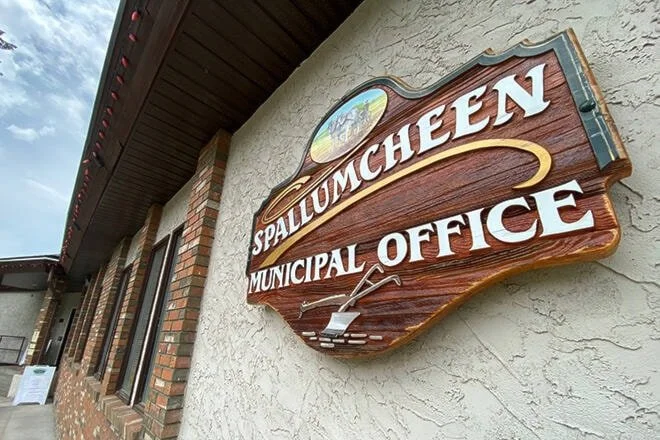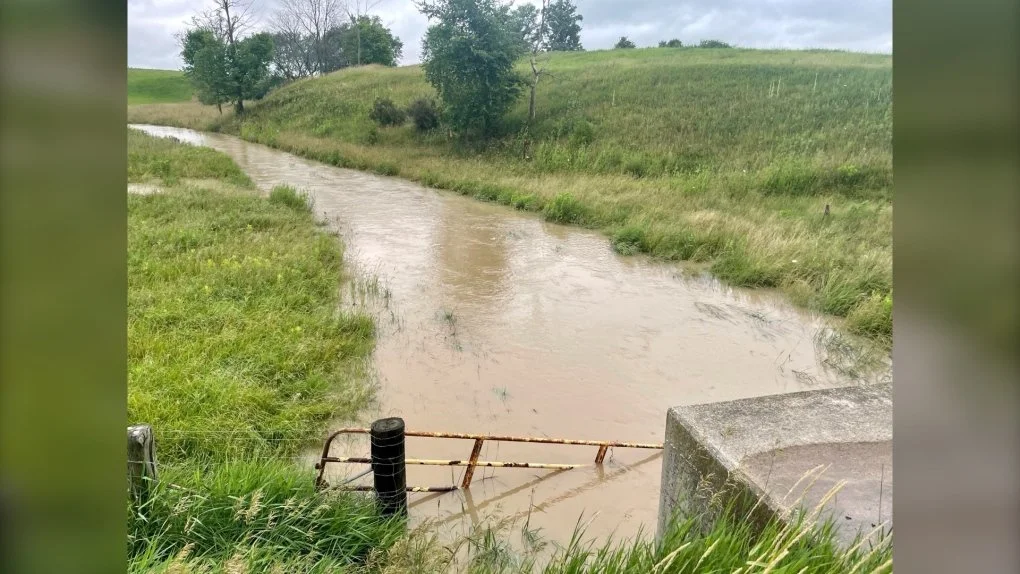Residents say they're frustrated with the slow progress of the cleanup of two Etobicoke creeks nearly a month after runoff from a massive industrial fire polluted them and caused devastation to wildlife. Ontario's Ministry of Environment, Conservation and Parks says it is continuing to assess the environmental impact after a six-alarm fire on Aug. 11 at Brenntag Canada, a chemical distribution company that operates an industrial building in north Etobicoke, caused runoff to enter both Mimico Creek and Humber Creek.
Dead fish, ducks found after runoff from industrial fire seeps into 2 Toronto creeks, province says
Runoff from a massive industrial fire in Etobicoke on Friday has left dead fish and ducks in a Toronto creek, the Ontario environment ministry said on Monday. Some of the ducks in Mimico Creek that have survived the runoff have been coated in an oily sludge, according to the Toronto Wildlife Centre.
Okanagan has one of the highest water use rates per person in Canada
A community consulting firm is asking, ‘Water you doing, Spall?’ The Township of Spallumcheen is looking to get the word out about the critical importance of water conservation. According to Spall reports, the Okanagan has one of the highest rates of water use per person in Canada, meaning there is less water available per person in the Okanagan than anywhere else in the country.
'The ground can’t handle any more water': UTRCA
Rivers, creeks, and streams are beginning to turn amidst the pressure of flood waters. While the City of London escaped heavy rain Wednesday evening through Thursday morning, some areas north and west of the city were not as fortunate. The Upper Thames River Conservation Authority (UTRCA) issued a flood alert. It follows several days of storms that have left the earth saturated.
An Indigenous approach to understanding water
“siwɬkʷ (WATER) IS SACRED AND IS LIFE FOR ALL PEOPLE. We know from our histories and our knowledge that water is one of the most important resources available to humans and animals.” But for Dawn Machin and Sarah Alexis, both from snƛ̓x̌ʷx̌ʷtan (Six-Mile Creek area in the North Arm of Okanagan Lake), there’s a disconnect between what water represents to humanity and how it’s perceived.
Salmon are dying in dried-up river beds in northern Yukon
Yukon River chinook and chum salmon in the Old Crow region of the territory are being hit with the perfect storm — not only are this year's runs expected to be dismal, but the life cycle of the salmon is being broken. Over the last several years, lower numbers of chinook and chum salmon have made the long journey from the ocean to creeks and streams at the mouth of the Porcupine River, spawned, and then died. The small fry would then make their way back to the Bering Sea in spring. But now many of the fertilized eggs left behind in the rivers are dying because large stretches of river are drying up in the early spring — and it's not exactly clear why.
Coastal GasLink hit with more stop work orders over water pollution concerns
Coastal GasLink has been issued stop work orders on a stretch of pipeline construction for the second time in just over a week, the latest in a pattern of environmental violations for polluting sensitive waterways. The pipeline project crosses about 625 lakes, rivers, creeks, wetlands, and streams in northern B.C. On Tuesday, the BC Environmental Assessment Office Compliance and Enforcement Branch said it had issued four stop work orders to Coastal GasLink late last week because erosion and sediment were negatively impacting the upper Anzac River watershed, about 130 kilometres northeast of Prince George.
$1.2B later, Teck Resources has barely put a dent in its pollution problems, documents show
As Teck Resources plans to distance itself from coal, government records show the mining giant remains a long way from solving the widespread contamination of local rivers and creeks — despite having already invested $1.2 billion in water treatment. Last year, selenium levels 267 times higher than what’s considered safe for aquatic life were detected in waters directly affected by Teck’s Elk Valley mines, according to an internal government meeting note obtained by The Narwhal through a freedom of information request.
VIDEO: Water sampling tracks down bacteria sources along Langley, Aldergrove rivers
Spot testing of creeks across South Langley and Surrey is the first step in reducing levels of bacteria that are affecting shellfish harvests downstream. On Monday, Feb. 6, Lisa Dreves of Langley Environmental Partners Society was out sampling from Langley and Abbotsford creeks that run south across the Canada-U.S. border into the Nooksack River. At a bridge in Otter Park off 248th Street, she flings an old plastic milk jug tied to the end of a rope into Bertrand Creek, hauling up about a litre of water. Smaller samples are poured into bottles for later testing. Meanwhile, another device dangled off the bridge checks the oxygen content and temperature of the stream, both important for fish.
Contractor fined $2.8 million for spills that killed hundreds of fish in Coquitlam, Surrey creeks
A construction contractor has been fined $2.8 million for releasing contaminated water into salmon-bearing creeks in Coquitlam and Surrey in 2017. Michels Canada Co., a construction contractor based out of Nisku, Alta., was ordered to pay the sum on Dec. 6, after pleading guilty to two charges under the Fisheries Act. “These creeks are inhabited by salmonids year-round, and the presence of juvenile salmonids in these creeks during the summertime low flow period and hot weather emphasizes the importance of this habitat,” stated Environment and Climate Change Canada (ECCC) on Dec. 8.
Is road salt killing salmon in B.C. streams? UBC researchers trying to find out
University of B.C. researchers are embarking on a five-year study to find out whether road salt is contributing to salmon mortality in B.C. streams. The team, led by Patricia Schulte, Chris Wood and Colin Brauner, also involves dozens of volunteer stream-keepers at 30 streams or creeks. Schulte, a professor in the Department of Zoology at UBC, said as the ice melts on the roads, it runs down into freshwater streams or can seep into the groundwater. Researchers know the salt can harm baby salmon or trout but what they don’t know yet is how much of the salt is winding up in the water.
Nature Conservancy of Canada announces campaign to save landscape in southern Alberta
The Nature Conservancy of Canada has announced a $6.9-million campaign to save a distinctive landscape near Waterton Lakes National Park in southern Alberta. The 1,650-hectare property, called The Yarrow, is located near the hamlet of Twin Butte, about 80 kilometres southwest of Lethbridge. The NCC says the property features grasslands, wetlands, creeks and mixed forests and includes 27 wildlife species of provincial or national significance — including grizzly bears, birds called bobolinks and little brown bats.
BLOG: An Ontario problem, a prairie concern
In the spring of 2018, Health Canada proposed a ban on all agricultural uses of two insecticides, thiamethoxam and clothianidin. Health Canada scientists said the insecticides, known as neonics, were accumulating in ponds, creeks and other water bodies near agricultural land. The concentrations were harmful to midges and mayflies and therefore posed a threat to birds and other animals that rely on the insects for food.
Road salt levels in some local creeks toxic to aquatic life, says riverkeeper
The amount of road salt that people, businesses, and cities are using over the winter is likely too much and is definitely hurting local waterways, according to the Ottawa Riverkeeper. The organization began monitoring how much road salt is making its way into local creeks last winter as part of its road salt monitoring pilot project. The Canadian Council of Ministers of the Environment has established federal guidelines around the amount of chloride — which is partly what salt breaks down into when it dissolves in water — in waterbodies.
Data gaps prevent assessment of most Canadian watersheds: WWF report
Spotty research and inconsistent monitoring have made it impossible to evaluate the health of most Canadian watersheds, a study has found. “It’s still largely unknown,” said Elizabeth Hendricks of the World Wildlife Fund, which has just released its second evaluation of the condition of Canada’s freshwater environments. Hendricks said the report points to the need for standardized, national water monitoring done by local communities.
















